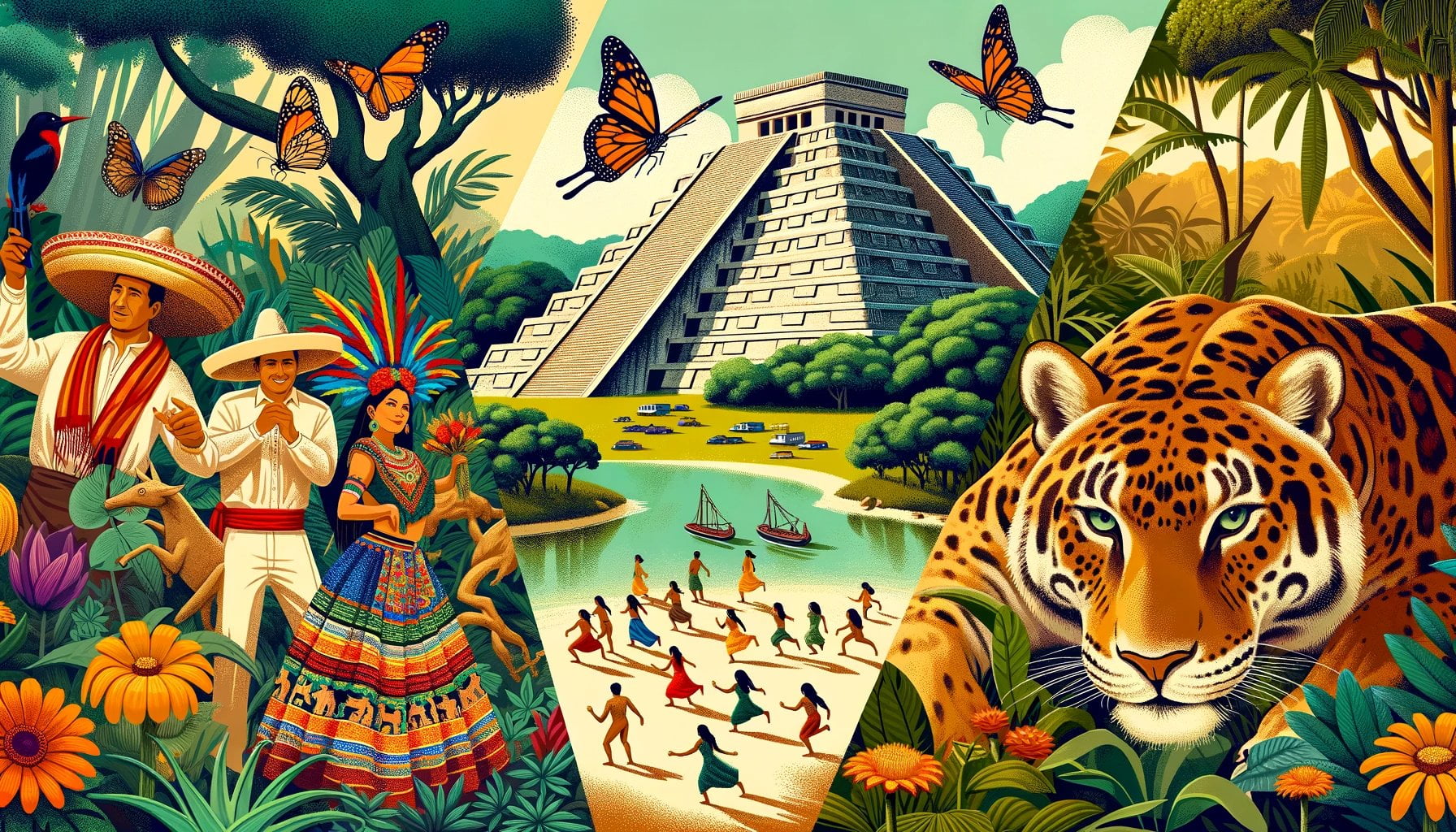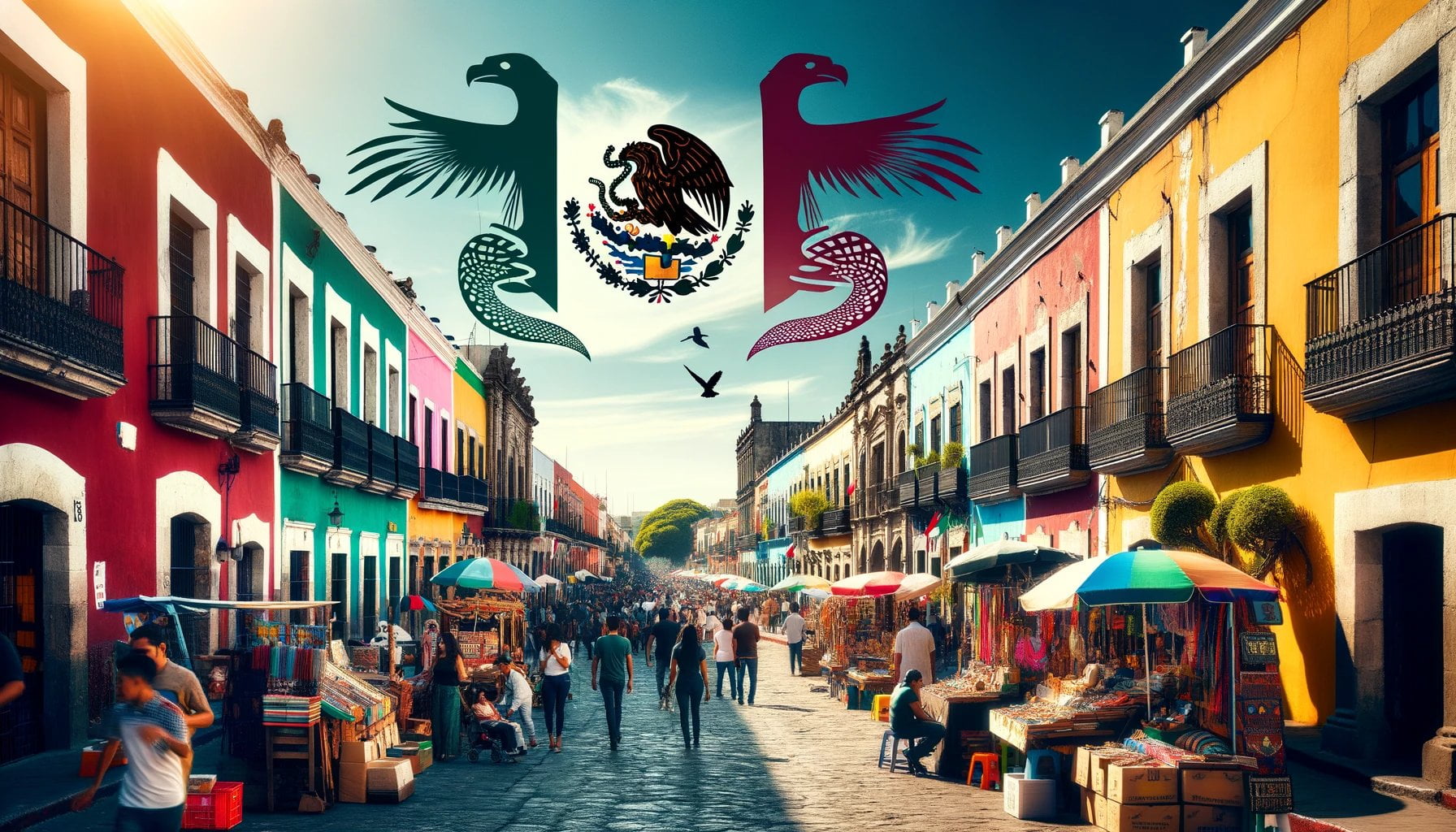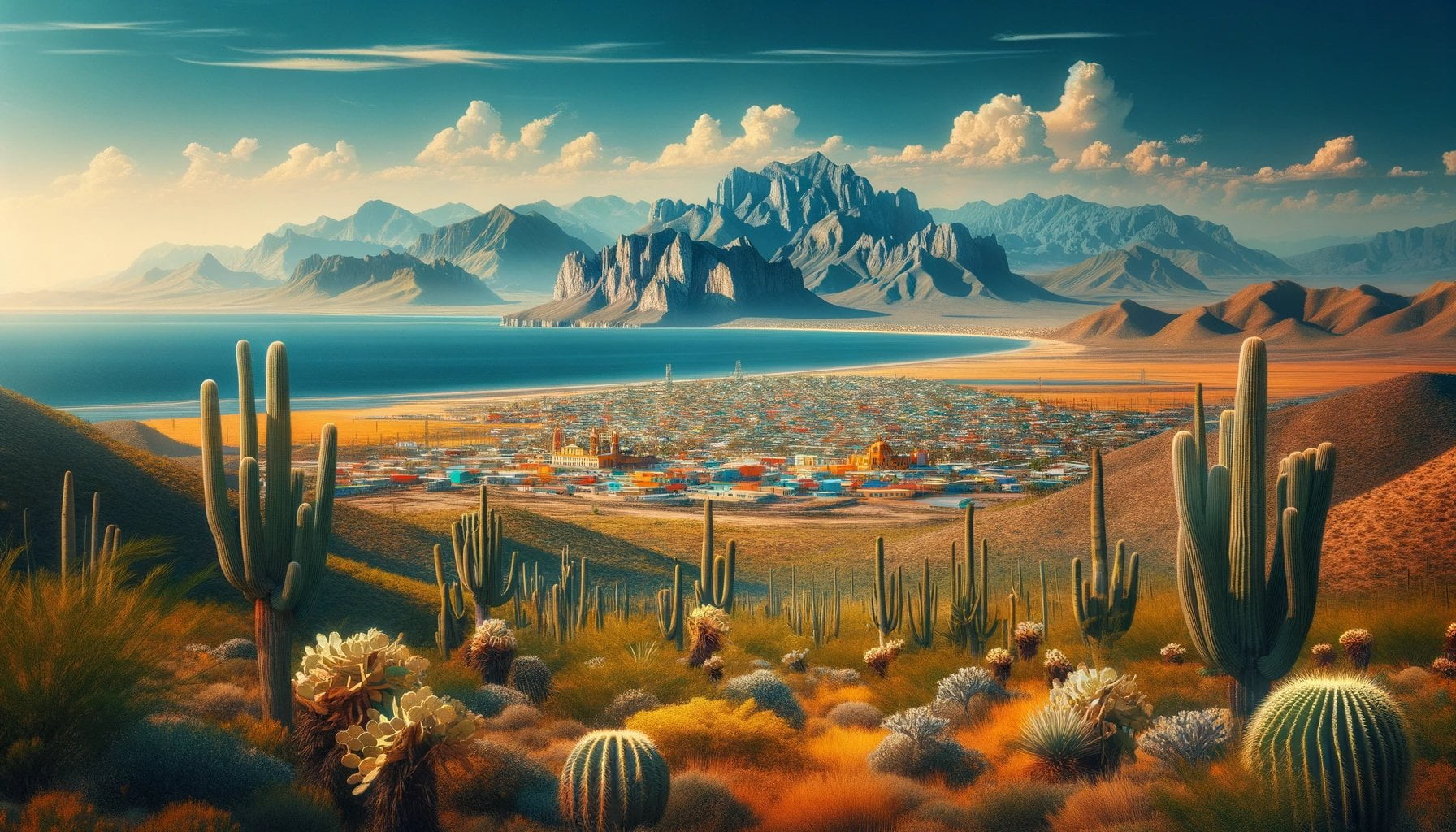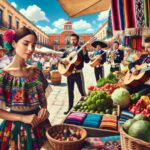Welcome to “Unveiling Mexico’s Wonders: Landscapes, Ancient Civilizations, and Culinary Delights.” In this article, we will embark on a journey through the mesmerizing tapestry of Mexico’s heritage, history, and vibrant traditions. Discover the awe-inspiring landscapes that will leave you breathless, delve into the secrets of ancient civilizations that shaped the country’s identity, and tantalize your taste buds with the vibrant culinary scene. Let’s explore three important facts about Mexico that will captivate your imagination and inspire your wanderlust.

Key Takeaways:
- Mexico is the most populous Spanish-speaking country in the world and has a rich Native American heritage.
- Mexico has a long history of ancient civilizations, including the Olmec, Maya, Toltec, and Aztec.
- Mexico is located in North America and shares borders with the United States, Guatemala, and Belize.
- Mexico boasts diverse geography, climate, and wildlife, including the largest wildcat in North America, the jaguar.
- The population of Mexico is a mix of mestizos, reflecting its history of Native American heritage and Spanish rule.
- Mexico has been a hub of great artists throughout its history.
What are 3 important facts about Mexico?
Mexico, a country known for its vibrant culture and rich history, holds a treasure trove of fascinating facts that will leave you in awe. Let’s delve into the three most important facts about Mexico that showcase its diverse landscapes, ancient civilizations, and tantalizing culinary scene.
1. Awe-Inspiring Landscapes
Mexico boasts an extraordinary range of landscapes that will take your breath away. From the breathtaking beaches of the Riviera Maya to the rugged canyons of Copper Canyon, this country offers a diverse array of natural wonders. Discover the magical underwater world of the Great Maya Barrier Reef, the second-largest coral reef system in the world. Immerse yourself in the enchanting beauty of the ancient forests in the Sierra Madre mountain range. Marvel at the mind-boggling size and beauty of the monarch butterfly migration in Michoacán. No matter where you venture in Mexico, you are bound to encounter landscapes that will leave an indelible mark on your soul.
2. Ancient Civilizations
Mexico is steeped in history, with a rich heritage of ancient civilizations that have left an indelible mark on its cultural landscape. Explore the ruins of the ancient city of Teotihuacan, where the awe-inspiring Pyramid of the Sun and Pyramid of the Moon stand tall as reminders of a once-mighty civilization. Transport yourself back in time at Chichen Itza, a UNESCO World Heritage Site and one of the New Seven Wonders of the World. Immerse yourself in the mysteries of the Maya civilization as you explore the intricate temples and observatories. Discover the fascinating archaeological site of Palenque, hidden within the lush jungles of Chiapas, and witness the intricate stone carvings that depict ancient rituals and ceremonies. Mexico’s ancient civilizations offer a captivating glimpse into the country’s rich and diverse history.
3. Vibrant Culinary Scene
One cannot truly understand Mexico without experiencing its vibrant culinary scene. Mexican cuisine is a fusion of indigenous Mesoamerican flavors and Spanish influences, resulting in a tantalizing array of dishes that cater to every palate. Indulge in the mouthwatering street tacos, bursting with flavor from succulent meats and fresh salsas. Explore the diverse flavors of mole, a complex sauce that combines spices, chocolate, and chilies. Delight in the vibrant colors and flavors of traditional dishes like chiles en nogada or tamales. Savor the addictive taste of guacamole, made from the creamy richness of avocados. From the fiery heat of chilies to the subtle sweetness of cinnamon, Mexican cuisine is a sensory delight that will leave you craving for more.
In conclusion, Mexico’s awe-inspiring landscapes, ancient civilizations, and vibrant culinary scene showcase the incredible diversity and richness of this captivating country. Explore its natural wonders, delve into its intriguing history, and savor the flavors that will ignite your taste buds. So, what are you waiting for? Embark on a journey to uncover the wonders of Mexico and let its magic captivate your heart and soul.
Here are some interesting facts about Mexico. Did you know that Mexico is famous for its rich cultural heritage and ancient ruins? Click here to discover 4 fascinating facts about Mexico. 4 facts about mexico
Have you ever wondered what makes Mexico unique? Uncover a fun fact about Mexico by clicking here. What is a fun fact in Mexico?
Mexico is known for more than just its beautiful beaches. Find out what Mexico is famous for by clicking here. What is Mexico famous for?
The vibrant culinary scene in Mexico is renowned for its flavors, spices, and unique regional dishes.
Mexico is a country that captivates with its rich heritage, diverse landscapes, and ancient civilizations. But one aspect that truly stands out is its vibrant culinary scene. From the enticing aromas of street food to the intricate flavors of regional dishes, Mexican cuisine is a culinary journey like no other.
A Tapestry of Flavors and Spices
Mexican cuisine is an explosion of flavors and spices that delight the taste buds. Influenced by Aztec, Mayan, and Spanish traditions, it is a tapestry woven with history and cultural heritage. The bold and spicy flavors are a result of a harmonious blend of fresh, local ingredients, herbs, and aromatic spices.
Regional Delicacies and Culinary Regions
Mexico is divided into seven culinary regions, each with its own distinct flavors and dishes. These regions are influenced by geography, history, and the availability of ingredients. From the seafood-rich coastal cuisine of Baja California to the hearty and flavorful dishes of the Yucatan Peninsula, each region offers a unique culinary experience.
Mexico City: Gastronomical Hub and Street Food Haven
Central Mexico’s gastronomical hub is Mexico City, a vibrant metropolis that showcases the country’s culinary prowess. The city is a melting pot of flavors, where street food reigns supreme. Explore the bustling markets and sample mouthwatering delicacies like tacos al pastor, a beloved favorite with its succulent marinated pork and pineapple.
Fusion and Evolution of Mexican Cuisine
Mexican cuisine is an amalgamation of foods and flavors from different geographic regions. It has evolved over thousands of years, integrating ingredients and techniques from various cultures. This fusion has resulted in a diverse array of dishes that celebrate the country’s multicultural heritage.
The Cultural Significance of Mexican Cuisine
Food plays a significant role in Mexican culture, acting as a means of preserving traditions and combating homesickness for Mexican immigrants. It is a vibrant celebration of identity and community. The use of vibrant colors, fresh ingredients, and complex flavors reflects the country’s passionate spirit and zest for life.
Through its unique flavors, spices, and regional dishes, the vibrant culinary scene in Mexico provides a sensory experience that takes you on a journey through the country’s rich history and diverse traditions.
Key Takeaways:
- Mexican cuisine is an explosion of flavors and spices, reflecting a blend of Aztec, Mayan, and Spanish influences.
- Mexico is divided into seven culinary regions, each showcasing its own unique flavors and dishes.
- Mexico City is a gastronomical hub known for its vibrant street food scene, offering delights like tacos al pastor.
- Mexican cuisine is a fusion of different cultures, constantly evolving over thousands of years.
- Mexican cuisine holds deep cultural significance, acting as a means of preserving traditions and fostering community.
Sources:
– TheTravel – Culinary Delights: Mexico’s Most Iconic Food Dishes … – TheTravel
– Wikipedia – Mexican cuisine – Wikipedia
Mexico is a Country Rich in Cultural Traditions, Celebrated through Vibrant Festivals and Events
Mexico is a country known for its rich and vibrant cultural traditions, which come alive through a myriad of colorful festivals and events. From ancient traditions rooted in indigenous cultures to modern celebrations influenced by the country’s diverse heritage, Mexico offers a fascinating tapestry of traditions that captivate locals and visitors alike.
Celebrating Mexico’s Cultural Traditions: A Kaleidoscope of Festivals and Events
Mexico’s cultural traditions are a reflection of its unique history and blend of influences from indigenous civilizations and European colonization. The country’s rich and diverse heritage is celebrated throughout the year, with numerous festivals and events that showcase the depth and vibrancy of Mexican culture.
1. Day of the Dead
One of the most iconic and widely celebrated festivals in Mexico is the Day of the Dead. This annual event takes place on November 1st and 2nd and is a vibrant and colorful homage to deceased loved ones. Families prepare altars adorned with marigold flowers, photos, and their loved ones’ favorite foods. Parades, music, and elaborate sugar skull decorations also contribute to the festive atmosphere. The Day of the Dead offers a unique opportunity to honor and remember those who have passed away while celebrating the cycle of life.
Source: Culture Trip
2. Mexican Independence Day
Contrary to popular belief, Mexican Independence Day is not celebrated on Cinco de Mayo but on September 16th. This nationwide celebration commemorates the country’s independence from Spanish colonial rule. Parades, concerts, fireworks, and lively street parties fill the air with an infectious spirit of patriotism and pride. Mexican Independence Day is a testament to the resilience and courage of the Mexican people throughout history.
Source: Culture Trip
3. Cinco de Mayo
Although not a national holiday in Mexico, Cinco de Mayo holds cultural significance and is commemorated as a festive event, especially in the city of Puebla. Cinco de Mayo marks the Mexican victory over French forces in the Battle of Puebla. Festivities include parades, traditional dances, and vibrant displays of Mexican pride. While the holiday is not as widely celebrated as Day of the Dead or Mexican Independence Day, it still offers an opportunity to embrace and appreciate Mexican history and heritage.
4. Dia De Los Muertos (Day of the Dead)
Dia De Los Muertos is an integral part of Mexican culture and is celebrated annually on November 1st and 2nd. This colorful and joyful holiday is a time to honor and remember deceased loved ones. Families create intricate altars adorned with marigold flowers, photographs, and their loved ones’ favorite foods and beverages. Festivities include parades, feasting, and the creation of breathtaking sugar skull decorations. Dia De Los Muertos is a beautiful expression of Mexican traditions and serves as a reminder of the deep connection between the living and the deceased.
Source: Layer Culture
5. Piñatas
Piñatas are an iconic part of Mexican celebrations, delighting children and adults alike. These colorful, paper-mache creations take the form of various animals and shapes, filled with candy or small toys. The piñata is suspended from above, and blindfolded participants take turns trying to break it open with a stick. Piñatas are a joyous and interactive activity that adds a sense of playfulness to special occasions, such as birthdays and religious holidays.
Source: Layer Culture
6. Celebration of Saint Cecilia
As music holds a special place in Mexican culture, the Celebration of Saint Cecilia honors the patron saint of music. This lively celebration takes place in various cities and towns across Mexico and includes processions, live music performances, and vibrant festivals. The Celebration of Saint Cecilia showcases the country’s deep appreciation for music, highlighting its power to bring people together and uplift spirits.
Source: Layer Culture
Key Takeaways:
- Mexico’s cultural traditions are a vibrant and integral part of the country’s identity.
- Festivals and events like the Day of the Dead and Mexican Independence Day provide a glimpse into the depth and richness of Mexican culture.
- Piñatas and the Celebration of Saint Cecilia exemplify the interactive and joyful nature of Mexican traditions.
- These cultural events offer visitors a unique opportunity to immerse themselves in the beauty and diversity of Mexico’s heritage.
Sources:
– Culture Trip
– Layer Culture
The country’s economy is heavily dependent on tourism, making it a popular destination for travelers from around the world.
Mexico, a land filled with wonders and rich cultural heritage, has thrived as a popular destination for travelers from around the world. Its economy heavily relies on tourism, which has played a vital role in shaping the nation’s growth and development. In this article, we will delve deeper into the relationship between the Mexican economy and tourism, exploring its significance and impact.
Understanding the Impact of Tourism on Mexico’s Economy
Mexico’s economy has long been intertwined with the vibrant tapestry of its tourism industry. As one of the most important sectors in the world economy, tourism accounts for a substantial share of the country’s GDP. Before the COVID-19 pandemic, travel and tourism contributed significantly to Mexico’s economic growth, supporting millions of jobs and stimulating overall development.
The pandemic, however, has had a profound impact on tourism-dependent economies worldwide, and Mexico is no exception. The loss of international revenues has been devastating, posing numerous challenges for the country’s economic recovery. Despite these hardships, the United Nations World Tourism Organization (UNWTO) recognizes the crucial role of tourism for Mexico’s future economic revitalization.
A Dynamic Relationship: Tourism and Economic Growth
A study published in the Future Business Journal explores the intricate relationship between tourism and economic growth. This research supports the tourism-led growth hypothesis (TLGH), highlighting a bi-directional causal relationship between tourism and economic growth. The study validates the “feedback hypothesis,” which suggests that tourism and economic growth influence each other positively.
Mexico’s diverse landscapes, ancient civilizations, and culinary delights have all contributed to making it an attractive destination for global travelers. The country’s government recognizes the potential of the tourism sector to drive socio-economic growth and inclusive development. By promoting tourism, Mexico can leverage its unique cultural heritage, breathtaking natural beauty, and rich historical sites to boost its economy.
Key Takeaways:
- The pandemic has had a significant impact on tourism-dependent economies worldwide.
- Before COVID-19, travel and tourism played a crucial role in the global economy, accounting for 10% of global GDP and over 320 million jobs.
- A study supports the tourism-led growth hypothesis, indicating a bi-directional causal relationship between tourism and economic growth.
- Tourism has the potential to address socio-economic growth and inclusive development.
- The United Nations World Tourism Organization (UNWTO) emphasizes the importance of tourism for economic recovery.
Citations:
– Impact of the Pandemic on Tourism – IMF F&D
– The relationship between tourism and economic growth – Future Business Journal

FAQ
Q1: What are three important facts about Mexico?
A1: Three important facts about Mexico are: 1) Mexico is the most populous Spanish-speaking country in the world and has a rich Native American heritage. 2) Mexico has been inhabited for at least 11,000 years and has been home to several ancient civilizations, including the Olmec, Maya, Toltec, and Aztec. 3) Mexico is located in North America and is bordered by the United States, Guatemala, and Belize.
Q2: What is unique about Mexican cuisine?
A2: Mexican cuisine is unique due to its blend of Aztec, Mayan, and Spanish influences. The use of fresh, local ingredients, herbs, and spices results in bold and spicy flavors. Mexico is divided into seven culinary regions influenced by geography and history, with Mexico City being known as the gastronomical hub. Mexican cuisine is an amalgamation of foods and flavors from different geographic regions, incorporating a variety of vegetables and renowned for its vibrant flavors, aromatic spices, and diverse dishes.
Q3: How does Mexican culture celebrate important national days and festivals?
A3: Mexican culture celebrates important national days and festivals in various ways. The Day of the Dead is a nationwide event that honors deceased loved ones through vibrant and colorful festivities. Mexican Independence Day, celebrated on September 16th, is commemorated nationwide with parades, concerts, and fireworks. Cinco de Mayo, although not a national holiday, is still celebrated as a cultural event, particularly in Puebla where it commemorates the Mexican victory over French forces. Other celebrations include Dia De Los Muertos (Day of the Dead), piñatas, and the Celebration of Saint Cecilia, which honors the patron saint of music through processions, live music performances, and festivals.
Q4: How has the COVID-19 pandemic affected tourism in Mexico?
A4: The COVID-19 pandemic has had a significant impact on tourism in Mexico. Tourism-dependent economies have suffered due to the loss of international revenues. Before the pandemic, travel and tourism accounted for 10 percent of global GDP and over 320 million jobs. The relationship between tourism and economic growth has been explored, with studies supporting the tourism-led growth hypothesis (TLGH) and validating the “feedback hypothesis.” The United Nations World Tourism Organization (UNWTO) emphasizes the importance of tourism for economic recovery, and the contribution of travel and tourism to GDP is expected to reach 10.8% by 2026.
Q5: What modes of transportation are commonly used in international tourism to Mexico?
A5: The most widely used modes of transportation in international tourism to Mexico are air and road transportation. Air travel allows for convenient and efficient access to different regions of Mexico, with international airports located in major cities. Road transportation, such as buses and private vehicles, provides flexibility for exploring the diverse landscapes and attractions within the country.
- Unlocking Francis Alexander Shields’ Finance Empire: A Comprehensive Biography - July 12, 2025
- Unveiling Francis Alexander Shields: A Business Legacy - July 12, 2025
- Francis Alexander Shields’ Business Career: A Comprehensive Overview - July 12, 2025















